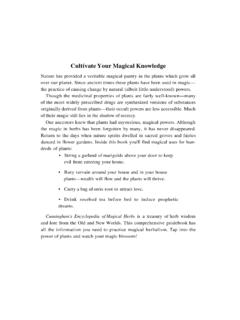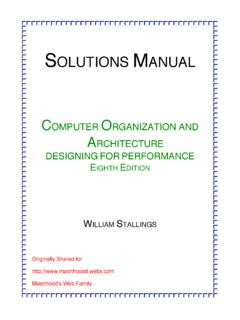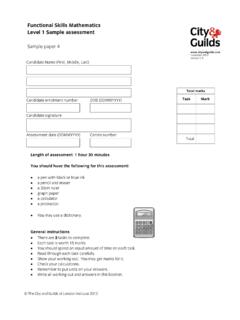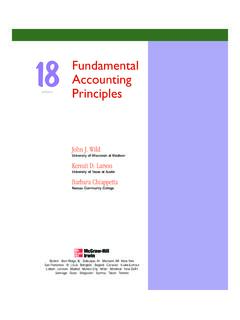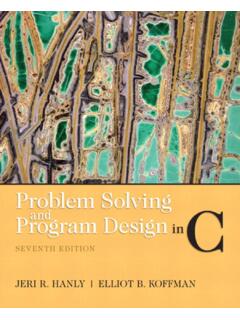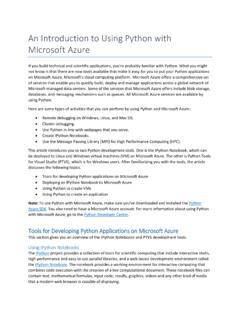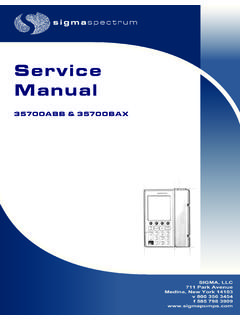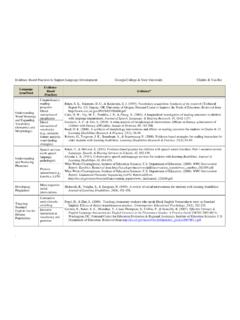Transcription of C# 4.0
1 C# : The Complete ReferenceAbout the AuthorHerbert Schildt is a leading authority on C#, C++, C, and Java. His programming books have sold millions of copies worldwide and have been translated into all major foreign languages. He is the author of numerous bestsellers, including Java: The Complete Reference, C++: The Complete Reference, and C: The Complete Reference,among many others. Although interested in all facets of computing, his primary focus is computer languages, including compilers, interpreters, and robotic control languages. He also has an active interest in the standardization of languages. Schildt holds both graduate and undergraduate degrees from the University of Illinois. He can be reached at his consulting office at (217) 586-4683.
2 His web site is the Technical EditorMichael Howard is a principal security program manager on the Trustworthy Computing (TwC) Group s Security Engineering team at Microsoft, where he is responsible for managing secure design, programming , and testing techniques across the company. Howard is an architect of the Security Development Lifecycle (SDL), a process for improving the security of Microsoft s began his career with Microsoft in 1992 at the company s New Zealand office, working for the first two years with Windows and compilers on the Product Support Services team and then with Microsoft Consulting Services, where he provided security infrastructure support to customers and assisted in the design of custom solutions and development of software.
3 In 1997, Howard moved to the United States to work for the Windows division on Internet Information Services, Microsoft s next-generation web server, before moving to his current role in is an editor of IEEE Security & Privacy, a frequent speaker at security-related conferences, and he regularly pub-lishes articles on secure coding and design. Howard is the co-author of six security books, including the award-winning Writing Secure Code, 24 Deadly Sins of Software Security, TheSecurity Development Lifecycle, and his most recent release, Writing Secure Code for Windows # : The Complete ReferenceHerbert SchildtNew York Chicago San Francisco Lisbon London Madrid Mexico City Milan New Delhi San Juan Seoul Singapore Sydney TorontoCopyright 2010 by The McGraw-Hill Companies.
4 All rights reserved. Except as permitted under the United States Copyright Act of 1976, no part of this publication may be reproduced or distributed in any form or by any means, or stored in a database or retrieval system, without the prior written permission of the : 978-0-07-174117-0 MHID: 0-07-174117-8 The material in this eBook also appears in the print version of this title: ISBN: 978-0-07-174116-3, MHID: trademarks are trademarks of their respective owners. Rather than put a trademark symbol after every occurrence of a trademarked name, we use names in an editorial fashion only, and to the benefi t of the trademark owner, with no intention of infringement of the trademark. Where such designations appear in this book, they have been printed with initial eBooks are available at special quantity discounts to use as premiums and sales promotions, or for use in corporate training programs.
5 To contact a representative please e-mail us at trademarks or copyrights mentioned herein are the possession of their respective owners and McGraw-Hill makes no claim of ownership by the mention of products that contain these has been obtained by McGraw-Hill from sources believed to be reliable. However, because of the possibility of human or mechanical error by our sources, McGraw-Hill, or others, McGraw-Hill does not guarantee the accuracy, adequacy, or completeness of any information and is not responsible for any errors or omissions or the results obtained from the use of such OF USEThis is a copyrighted work and The McGraw-Hill Companies, Inc. ( McGrawHill ) and its licensors reserve all rights in and to the work.
6 Use of this work is subject to these terms. Except as permitted under the Copyright Act of 1976 and the right to store and retrieve one copy of the work, you may not decompile, disassemble, reverse engineer, reproduce, modify, create derivative works based upon, transmit, distribute, disseminate, sell, publish or sublicense the work or any part of it without McGraw-Hill s prior consent. You may use the work for your own noncommercial and personal use; any other use of the work is strictly prohibited. Your right to use the work may be terminated if you fail to comply with these WORK IS PROVIDED AS IS. McGRAW-HILL AND ITS LICENSORS MAKE NO GUARANTEES OR WARRANTIES AS TO THE ACCURACY, ADEQUACY OR COMPLETENESS OF OR RESULTS TO BE OBTAINED FROM USING THE WORK, INCLUDING ANY INFORMATION THAT CAN BE ACCESSED THROUGH THE WORK VIA HYPERLINK OR OTHERWISE, AND EXPRESSLY DISCLAIM ANY WARRANTY, EXPRESS OR IMPLIED, INCLUDING BUT NOT LIMITED TO IMPLIED WARRANTIES OF MERCHANTABILITY OR FITNESS FOR A PARTICULAR PURPOSE.
7 McGraw-Hill and its licensors do not warrant or guarantee that the functions contained in the work will meet your requirements or that its operation will be uninterrupted or error free. Neither McGraw-Hill nor its licensors shall be liable to you or anyone else for any inaccuracy, error or omission, regardless of cause, in the work or for any damages resulting therefrom. McGraw-Hill has no responsibility for the content of any information accessed through the work. Under no circumstances shall McGraw-Hill and/or its licensors be liable for any indirect, incidental, special, punitive, consequential or similar damages that result from the use of or inability to use the work, even if any of them has been advised of the possibility of such damages.
8 This limitation of liability shall apply to any claim or cause whatsoever whether such claim or cause arises in contract, tort or at a Glance Part I The C# Language 1 The Creation of C# .. 3 2 An Overview of C# .. 11 3 Data Types, Literals, and Variables .. 37 4 Operators .. 65 5 Program Control Statements .. 87 6 Introducing Classes and Objects .. 111 7 Arrays and Strings .. 139 8 A Closer Look at Methods and Classes .. 167 9 Operator Overloading .. 221 10 Indexers and Properties .. 253 11 Inheritance .. 277 12 Interfaces, Structures, and Enumerations .. 319 13 Exception Handling.
9 345 14 Using I/O .. 371 15 Delegates, Events, and Lambda Expressions .. 411 16 Namespaces, the Preprocessor, and Assemblies .. 449 17 Runtime Type ID, Refl ection, and Attributes .. 471 18 Generics .. 507 19 LINQ .. 565 20 Unsafe Code, Pointers, Nullable Types, Dynamic Types, and Miscellaneous Topics .. 605 Part II Exploring the C# Library 21 Exploring the System Namespace .. 639 22 Strings and Formatting .. 691 23 Multithreaded programming , Part One .. 735 24 Multithreading, Part Two: Exploring the Task Parallel Library and PLINQ .. 783 25 Collections, Enumerators, and Iterators.
10 817 26 Networking Through the Internet Using .. 895 A Documentation Comment Quick Reference .. 921 Index .. 925vThis page intentionally left blank ContentsSpecial Thanks .. xxiPreface .. xxiii Part I The C# Language 1 The Creation of C# .. 3C# s Family Tree .. 3C: The Beginning of the Modern Age of programming .. 3 The Creation of OOP and C++ .. 4 The Internet and Java Emerge .. 4 The Creation of C# .. 5 The Evolution of C# .. 7 How C# Relates to the .NET Framework .. 8 What Is the .NET Framework? .. 8 How the Common Language Runtime Works .. 8 Managed vs. Unmanaged Code .. 9 The Common Language Specifi cation.
